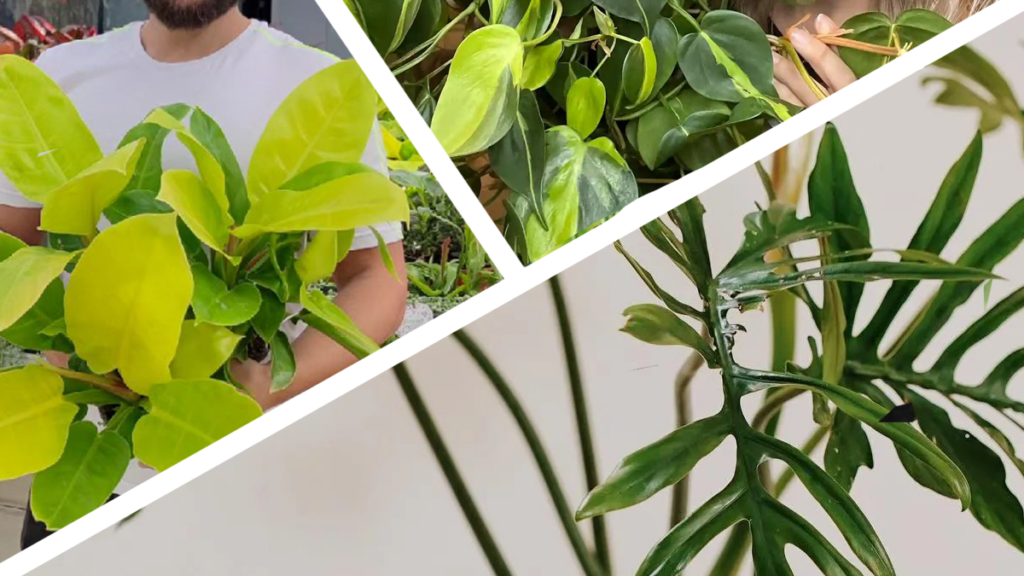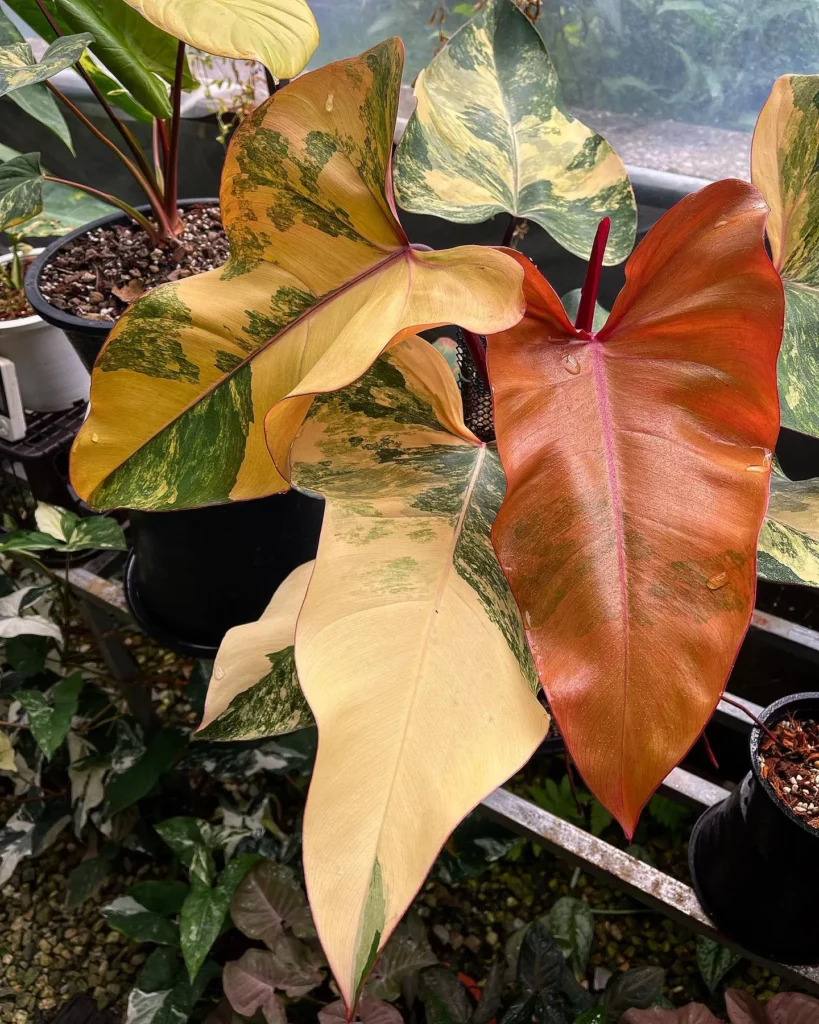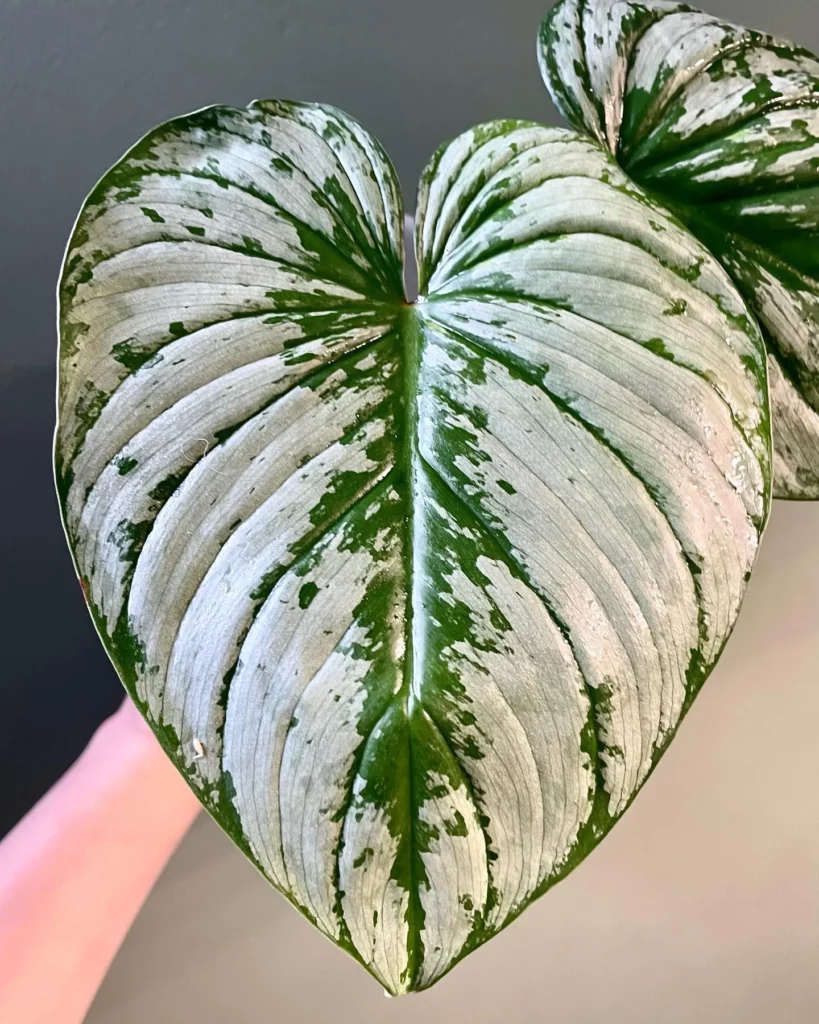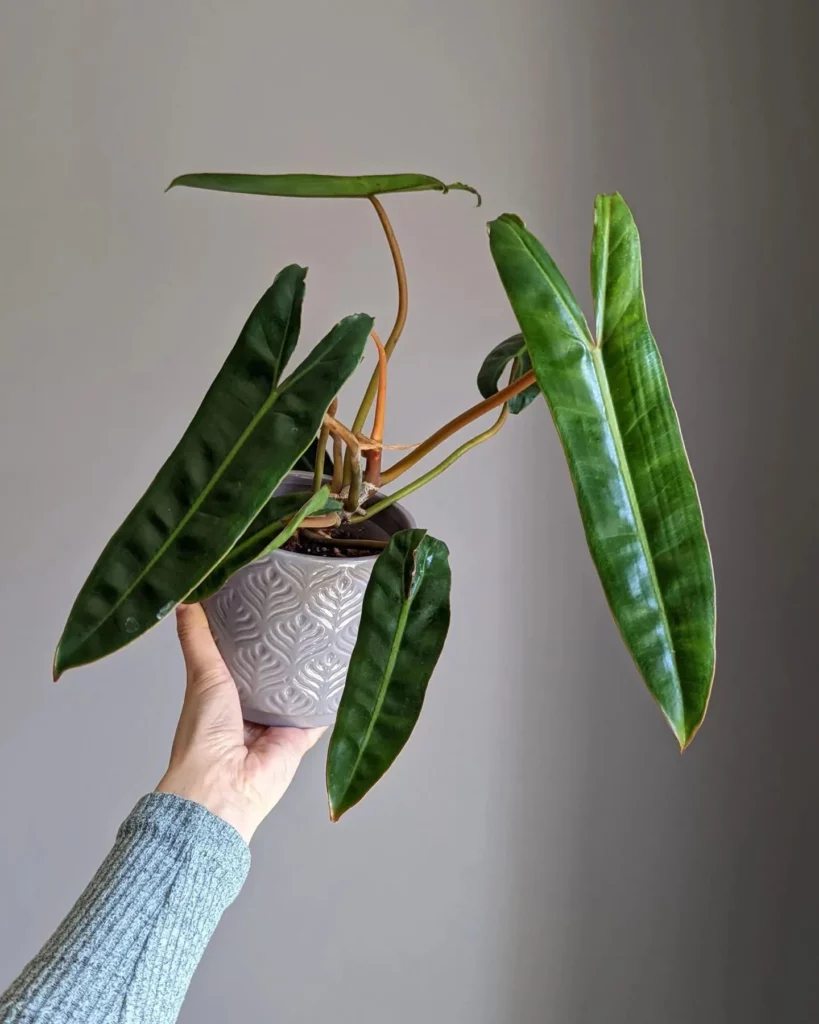Welcome to my guide on caring for and growing Philodendron Grazielae. This stunning climbing plant with its glossy green foliage is a popular choice among plant enthusiasts. Not only is it visually appealing, but it’s also relatively easy to care for, making it perfect for beginners.
Key Takeaways:
- Philodendron Grazielae is an easy-to-care-for climbing plant with heart-shaped glossy green foliage.
- Philodendron Grazielae can reach heights of up to 3 feet indoors, making it suitable for smaller spaces.
Philodendron Grazielae History



Philodendron Grazielae, also known as the Grazielae Philodendron, has a fascinating history rooted in its native land of Peru. This tropical rainforest plant has captivated plant enthusiasts around the world with its unique climbing nature and medium-sized heart-shaped leaves. Its charm and ease of care make it a popular choice for beginners and experienced plant lovers alike.
The origins of Philodendron Grazielae can be traced back to the lush rainforests of Peru, where it thrives in the warm and humid climate. This plant was first discovered and classified in the botanical world, and its popularity quickly spread due to its beautiful foliage and low maintenance requirements.
Philodendron Grazielae Identification



Philodendron Grazielae is a beautiful plant with unique features that make it easily identifiable. Here is a quick guide to help you identify this stunning plant:
1. Glossy Green Foliage
The leaves of Philodendron Grazielae are glossy and vibrant green in color. They have a beautiful shine that adds to the overall appeal of the plant. The foliage is heart-shaped, which is a classic characteristic of many philodendron varieties. The leaves can grow up to 5 inches in length, creating a lush and full appearance.
2. Compact Size
Philodendron Grazielae is a relatively small plant that can fit well in smaller spaces. When grown indoors, it can reach heights of up to 3 feet, making it a versatile choice for any home or office environment. The compact size also makes it easier to care for and maintain, especially for beginners.
3. Climbing Nature
Similar to other philodendron varieties, Philodendron Grazielae is a climbing plant. It has aerial roots that allow it to attach itself to a support structure, such as a moss pole or trellis. This climbing nature gives the plant a unique and visually appealing aspect, making it a fantastic choice for those who enjoy plants with a bit of height and movement.
Philodendron Grazielae Growth Facts



When it comes to growth, Philodendron Grazielae is a plant that knows how to thrive. With its fast growth rate, this gorgeous climbing variety can quickly stretch out and fill up space, making it an exciting addition to any plant collection. Whether you’re a beginner or an experienced plant enthusiast, watching the Philodendron Grazielae grow can be a rewarding experience.
To promote optimal growth, it’s important to provide the right conditions for your Philodendron Grazielae. This includes placing it in a spot that receives bright indirect sunlight, as this plant thrives in well-lit environments. Additionally, maintaining temperatures between 68-80F can help stimulate growth and keep your plant happy and healthy.
Another factor that contributes to the rapid growth of Philodendron Grazielae is its ability to adapt to different humidity levels. While this plant can tolerate average humidity, providing higher humidity levels can promote even lusher growth. Consider misting your plant or placing it in a room with a humidifier to create a more tropical environment.
How Big Does a Philodendron Grazielae Get?



One of the appealing features of Philodendron Grazielae is its compact size, making it suitable for smaller spaces. When grown indoors, this plant can reach heights of up to 3 feet. Its relatively small stature allows it to fit well on tabletops, shelves, or as a hanging plant. Despite its smaller size, Philodendron Grazielae still brings a vibrant touch of green to any space.
To accommodate the plant’s growth and prevent it from becoming overcrowded, occasional pruning may be necessary. Trimming back any leggy or wayward growth will help maintain the plant’s shape and promote healthier growth. Regular pruning also ensures that the plant remains within its desired size, making it easier to fit into different areas of your home.
When it comes to the width of Philodendron Grazielae, the plant can spread out and fill its space by producing trailing vines. These vines can be trained to grow along support structures or allowed to cascade gracefully over the edges of pots. As the plant grows, it adds an elegant and lush appeal to its surroundings.
Philodendron Grazielae Care
When it comes to caring for Philodendron Grazielae, you’ll be happy to know that it’s a low-maintenance plant that thrives with minimal effort. Here are a few key aspects to consider when caring for this beautiful climbing variety:
1. Moderate Sunlight:
Philodendron Grazielae prefers bright but indirect sunlight. Place it near a window that provides ample brightness without exposing it to direct sunlight. Too much sun can scorch the leaves and cause discoloration.
2. Well-Draining Soil:
Using a well-draining soil mix is crucial for the health of your Philodendron Grazielae. Opt for a combination of commercial potting mix, peat moss or coco coir, and perlite. This blend allows excess water to escape, preventing root rot.
3. Regular Watering:
While Philodendron Grazielae enjoys slightly moist soil, it’s important not to overwater it. Allow the top two inches of soil to dry out before watering. During the winter months, reduce watering frequency to avoid soggy soil.
4. Occasional Fertilization:
Philodendron Grazielae benefits from monthly fertilization during the spring and summer seasons. Use a balanced liquid fertilizer at a diluted strength to provide the necessary nutrients for healthy growth. However, refrain from fertilizing during the fall and winter months.
Philodendron Grazielae Soil
When it comes to the soil requirements for your Philodendron Grazielae, it’s important to provide a well-draining mix that allows excess water to escape. A suitable soil blend can be created by combining a commercial potting mix, peat moss or coco coir, and perlite. This combination not only promotes adequate drainage but also ensures the availability of essential nutrients for your plant’s growth.
The commercial potting mix provides a good base for your Philodendron Grazielae, while the addition of peat moss or coco coir helps increase moisture retention without causing waterlogging. Lastly, perlite, a lightweight volcanic rock, creates air pockets in the soil, preventing compaction and aiding in drainage.
Benefits of well-draining soil for Philodendron Grazielae:
- Prevents root rot: Excess water accumulation can lead to root rot in your Philodendron Grazielae. A well-draining soil mix ensures that water flows through the pot without sitting at the bottom, reducing the risk of root rot.
- Prevents soil compaction: Aeration is crucial for the health of your plant’s roots. Well-draining soil with perlite helps create air pockets, allowing roots to breathe and preventing compaction.
- Optimizes nutrient uptake: The combination of a commercial potting mix, peat moss or coco coir, and perlite provides a balanced mix of organic matter and mineral nutrients, promoting optimum nutrient availability for your Philodendron Grazielae.
Philodendron Grazielae Fertilizer
Proper fertilization is essential for the healthy growth and development of Philodendron Grazielae. While this plant does not require frequent feedings, providing it with a balanced liquid fertilizer can be beneficial, especially during the active growth period in spring and summer. Monthly fertilization is generally sufficient to meet the plant’s nutritional needs.
When choosing a fertilizer, opt for a balanced formula with equal amounts of nitrogen (N), phosphorus (P), and potassium (K). Dilute the fertilizer to half or quarter strength, as the concentrated solution may cause leaf burn or fertilizer toxicity. Apply the diluted fertilizer to the soil following the manufacturer’s instructions.
It’s important to note that fertilization should be halted during the fall and winter months. Philodendron Grazielae enters a period of dormancy during this time, and fertilization can disrupt its natural growth cycle. Resume fertilization in the following spring to promote new growth and maintain the plant’s overall health.
No products found.
Philodendron Grazielae Watering
Proper watering is crucial for the health and vitality of your Philodendron Grazielae. As a general rule, it’s important to water the plant when the top two inches of the soil feel dry to the touch. Overwatering can lead to root rot and other issues, so it’s best to err on the side of underwatering rather than overwatering.
A good way to check the moisture level is to insert your finger into the soil. If it feels moist, hold off on watering for a few more days. If it feels dry, it’s time to give your Philodendron Grazielae a drink.
When watering, it’s important to thoroughly saturate the soil. Allow the water to flow through the drainage holes in the pot and remove any excess water that collects in the saucer. Philodendron Grazielae prefers slightly moist soil, but it does not like to sit in waterlogged conditions.
During the winter months when the plant’s growth slows down, reduce watering frequency. It’s important to strike a balance between keeping the soil moist and avoiding overwatering. By paying attention to the moisture level in the soil and adjusting your watering accordingly, you can ensure that your Philodendron Grazielae thrives.
Philodendron Grazielae Light Requirements
Proper lighting is crucial for the healthy growth of Philodendron Grazielae. This tropical plant thrives in bright indirect light, simulating its natural habitat in the rainforest. Placing your Philodendron Grazielae near a window that allows filtered sunlight is ideal. However, direct sunlight should be avoided, as it can cause leaf scorching and discoloration.
If you’re unsure about the intensity of light in a particular location, a simple test can help. Place your hand between the plant and the source of light. If you feel a gentle warmth on your hand, it indicates the light is indirect and suitable for your Philodendron Grazielae. On the other hand, if the light feels intense and hot, it’s best to move the plant to a spot with more shade.
Philodendron Grazielae Temperature & Humidity
When it comes to the temperature and humidity requirements of Philodendron Grazielae, maintaining a stable and suitable environment is crucial for its overall health and growth. This tropical plant thrives in temperatures between 68-80F, so it’s essential to keep it away from extreme fluctuations in temperature. Avoid placing the plant near heaters, air conditioning units, vents, and drafts to prevent any stress or damage.
While Philodendron Grazielae can tolerate average room humidity, providing added humidity can promote lush growth and prevent the leaves from drying out. One way to increase humidity is by placing the plant on a tray filled with pebbles and water. As the water evaporates, it creates a more humid microclimate around the plant. Alternatively, you can use a humidifier or regularly mist the leaves with water to mimic a tropical environment.
Temperature:
- Keep temperatures between 68-80F
- Avoid extreme fluctuations in temperature
- Avoid placing the plant near heaters, AC units, vents, and drafts
Humidity:
- Provide average room humidity
- Use a tray of pebbles and water or a humidifier to increase humidity
- Mist the leaves regularly to create a more humid environment
Philodendron Grazielae Propagation
If you’re looking to expand your Philodendron Grazielae collection, propagation is a simple and rewarding method. One way to propagate this beautiful plant is through stem cuttings.
To start, cut a stem with at least two leaves just below the leaf node. Make sure to choose a healthy stem for best results. Allow the cutting to callus, or form a dry, hardened surface, before proceeding.
Once the cutting has callused, you have two options: planting it directly in soil or placing it in water. If you choose soil, make a small hole and insert the cutting, ensuring it is securely rooted. If water propagation is your preference, place the cutting in a container with water, making sure the lower part of the stem is submerged.
Whether you choose soil or water propagation, ensure your Philodendron Grazielae cutting receives bright indirect light and a warm environment. With proper care and patience, you’ll soon see roots forming and new growth emerging from the cutting, giving you a brand-new plant to enjoy.
FAQ
What is the care and growth guide for Philodendron Grazielae?
Philodendron Grazielae is easy to care for and grows well with well-draining soil, bright indirect sunlight, temperatures between 68-80F, high humidity levels, and periodic fertilization.
What is the history of Philodendron Grazielae?
Philodendron Grazielae is a native plant of Peru and is known for its climbing nature and medium-sized heart-shaped leaves.
How can I identify Philodendron Grazielae?
Philodendron Grazielae has glossy green heart-shaped leaves that can grow up to 5 inches. Its leaves are easily recognizable due to their unique foliage.
What are some growth facts about Philodendron Grazielae?
Philodendron Grazielae is a fast-growing plant that can reach heights of up to 3 feet when grown indoors. Its compact size makes it suitable for smaller spaces.
How big does a Philodendron Grazielae get?
Philodendron Grazielae can reach heights of up to 3 feet when grown indoors.
How do I take care of Philodendron Grazielae?
Philodendron Grazielae is a low-maintenance plant that requires moderate sunlight, well-draining soil, and regular watering. It is drought-tolerant and does not require excessive care to thrive.
What type of soil does Philodendron Grazielae prefer?
Philodendron Grazielae prefers well-draining soil, such as a mix of commercial potting soil, peat moss or coco coir, and perlite.
How should I fertilize Philodendron Grazielae?
Philodendron Grazielae benefits from monthly feedings with a balanced liquid fertilizer at a diluted strength during the spring and summer months. Fertilization should be halted during the fall and winter seasons.
How often should I water Philodendron Grazielae?
Philodendron Grazielae should be watered when the top two inches of soil are dry. Overwatering should be avoided to prevent root rot. Watering frequency should be reduced during the winter months.
What are the light requirements for Philodendron Grazielae?
Philodendron Grazielae thrives in bright indirect light and should be placed near a window that provides adequate brightness. Direct sunlight should be avoided to prevent leaf scorching and discoloration.
What are the temperature and humidity preferences of Philodendron Grazielae?
Philodendron Grazielae prefers temperatures between 68-80F and can tolerate slight temperature fluctuations. It does not require high humidity levels for survival, but added humidity can promote lush growth.
How can I propagate Philodendron Grazielae?
Philodendron Grazielae can be propagated through stem cuttings. Cut a stem with at least two leaves below the leaf node and allow it to callus before planting it in soil or water.




